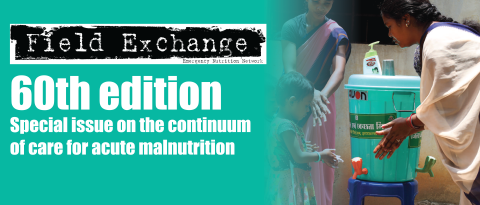Previous Field Exchange content on continuum of acute malnutrition care
Content previously published in Field Exchange is also relevant to this issue’s focus on continuity of care for acutely malnourished children. You can search online. Below is a selection of relevant articles from previous editions:
Phase 1 study results of the COMPAS trial and a summary of the study protocol for the economic evaluation:
Jeanette Bailey, Rachel Chase, Marko Kerac, André Briend, Mark Manary, Charles Opondo, Maureen Gallagher and Anna Kim (2016). Combined protocol for SAM/MAM treatment: The ComPAS study. Field Exchange 53, November 2016. p44.
The “ComPAS” trial combined treatment model for acute malnutrition: study protocol for the economic evaluation. Field Exchange 58, September 2018. p10.
Research on integrating treatment in community health worker in Bangladesh:
Community case management of severe acute malnutrition in southern Bangladesh. Field Exchange 42, January 2012. p11.
IRC research on low-literacy tools in South Sudan:
Naoko Kozuki, Casie Tesfai, Annie Zhou and Elburg van Boetzelaer (2019). Can low-literate community health workers treat severe acute malnutrition? A study of simplified algorithm and tools in South Sudan. Field Exchange 59, January 2019. p30.
MSF experiences on treatment admission simplification:
Kevin PQ Phelan, Candelaria Lanusse, Saskia van der Kam, Pascale Delchevalerie, Nathalie Avril and Kerstin Hanson (2015). Simplifying the response to childhood malnutrition: MSF’s experience with MUAC-based (and oedema) programming. Field Exchange 50, August 2015. p108.
Research on preventing malnutrition in sick children:
Does nutritional supplementation for two weeks prevent malnutrition in ill children? Field Exchange 55, July 2017. p36.
Susan Shepherd (2018). TreatFOOD study in Burkina Faso. Field Exchange 57, March 2018. p73.
Risk of relapse following moderate acute malnutrition treatment:
Heather Stobaugh and Mark Manary (2018). Relapse after treatment for moderate acute malnutrition: Risk factors and interventions to prevent it. Field Exchange 57, March 2018. p64.
WHO’s role in acute malnutrition management:
Zita Weise Prinzo, Adelheid Onyango, Dr Ferima-Coulibaly Zerbo, Hana Bekele, Dr Ngoy Nsenga and Adelheid Marschang (2017). Nutrition in health response in emergencies: WHO perspectives and developments. Field Exchange 56, December 2017. p89.
Experiences of an adapted (reduced RUTF) protocol by ACF in Myanmar (a precursor to the MANGO study highlighted in Field Exchange 60):
Naomi Cosgrove, Jane Earland, Philip James, Aurélie Rozet, Mathias Grossiord and Cecile Salpeteur (2012). Qualitative review of an alternative treatment of SAM in Myanmar. Field Exchange 42, January 2012. p6.
Review of CMAM innovations by Save the Children:
Anne Marie Kueter, Claudine Prudhon, Emily Keane and Megan Gayford (2018). Report on innovations in CMAM. Field Exchange 58, September 2018. p41.
RUTF supply:
Jan Komrska (2012). Increasing Access to Ready-to-use Therapeutic Foods (RUTF). Field Exchange 42, January 2012. p46.
Local versus offshore costs of RUTF and LNS. Field Exchange 54, February 2017. p36.
RUTF formulations:
Comparison of milk free v milk containing RUTF in SAM treatment in Zambia. Field Exchange 47, April 2014. p17.
Marta Ortiz Nunez (2010). Impact of local RUTF manufacture on farmers’ incomes in Malawi. Field Exchange 38, April 2010. p17.


